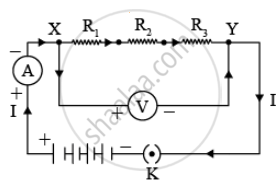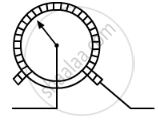Advertisements
Advertisements
Question
How will you infer with the help of an experiment that the same current flows through every part of the circuit containing three resistances in series connected to a battery?
Solution
Take three resistances R1, R2 and R3
- Connect them in series combination using battery, ammeter and key as shown in the diagram.

- First of all, connect the ammeter between battery and R1 and note down the reading.
- After that, connect the ammeter between R1 and R2 and note down the reading.
- After that, connect the ammeter between R3 and battery.
- Note down the reading of the ammeter in each steps.
It is observed that ammeter shows the same reading in all the three situations. This shows that same current flows through all the three resistors.
APPEARS IN
RELATED QUESTIONS
Use the data in the Table given below to answer the following –
Which among iron and mercury is a better conductor?
Table give below Electrical resistivity of some substances at 20°C
| Electrical resistivity of some substances at 20°C | ||
| − | Material | Resistivity (Ω m) |
| Conductors |
Silver | 1.60 × 10−8 |
| Copper | 1.62 × 10−8 | |
| Aluminium | 2.63 × 10−8 | |
| Tungsten | 5.20 × 10−8 | |
| Nickel | 6.84 × 10−8 | |
| Iron | 10.0 × 10−8 | |
| Chromium | 12.9 × 10−8 | |
| Mercury | 94.0 × 10−8 | |
| Manganese | 1.84 × 10−6 | |
| Alloys |
Constantan (alloy of Cu and Ni) |
49 × 10−6 |
| Manganin (alloy of Cu, Mn and Ni) |
44 × 10−6 | |
| Nichrome (alloy of Ni, Cr, Mn and Fe) |
100 × 10−6 | |
| Insulators | Glass | 1010 − 1014 |
| Hard rubber | 1013 − 1016 | |
| Ebonite | 1015 − 1017 | |
| Diamond | 1012 − 1013 | |
| Paper (dry) | 1012 | |
Name the electrical property of a material whose symbol is "omega".
Which among iron and mercury is a better conductor of electricity?
What do you understand by the "resistivity" of a substance?
Calculate the resistance of a copper wire 1.0 km long and 0.50 mm diameter if the resistivity of copper is 1.7 × 10−8 Ω m.
How does the resistance of a conductor depend on:
temperature of the conductor?
What would be the effect on the resistance of a metal wire of:
increasing its diameter?
What would be the effect on the resistance of a metal wire of:
increasing its temperature?
The figure blow shows a variable resistor in a dimmer switch.

How would you turn the switch to make the lights: (a) brighter, and (b) dimmer? Explain your answer.
The element used almost exclusively for filaments of incandescent lamps:
